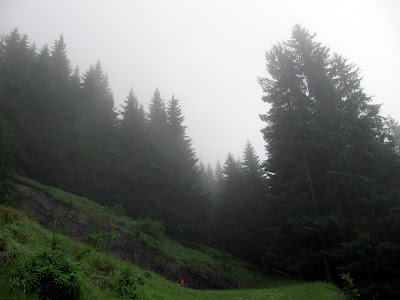http://kristofergoestonorway.blogspot.no/2012/07/telemark-part-1-boats-and-things.html
 |
| A traditional sod-roofed farm house, with a Norwegian farmer coming out of it. |
 |
| My first room. |
After we stood around for a bit, the manager ushered us inside and started handing out room keys. (A short comment which will become relevant shortly: The manager did not speak any English, and so because I have advanced to the point where I can hold a conversation in Norwegian (!), and despite her rather strong Telemark accent, I was one of the few people in our group who could communicate with her). They had passed a sign up sheet for rooms on the bus and though I was last to sign up, I had gotten a double room all to myself. I was feeling pretty lucky, but I guess the Norwegian Lutheran in me should have known that good luck like that doesn't last very long.
Just after I had put my stuff down and stepped outside for a breath of fresh air, the manager hailed me in Norwegian from the balcony and asked if I would be nice enough to switch rooms with one of the girls from our group. There wasn't really any reason for me to say no, so I agreed, whereupon the manager informed me that the girl needed to switch because she was claustrophobic. This puzzled me for all of the two minutes until I found the room that the girl had vacated. I'm lucky that I'm a thin guy, because the room was about three feet wide. It wasn't really bad, and I can understand why it made the girl claustrophobic. I didn't spend very much time in there other than at night, and it didn't affect my sleeping at all, so I guess I have nothing to complain about.Well, that's not quite true. Unfortunately, despite its person sized bed, the room must have been designed as guest lodgings for elves, gnomes, and/or trolls, because the door was all of four feet high. I probably hit my head on it at least five times during my stay. So, aside from a slight headache and the manager referring to me as Gutten med det lille roomet, "the boy with the little room", my minute lodgings were quite fine.
We had arrived about four in the afternoon, and dinner was not to be served until eight, and so the owner of the farm gave us a guided tour, and then settled us down to relate some Norwegian farmer wisdom. I wrote down some of the choice bits of advice and will pass them along here.
1. To keep ghostly hordes, spooks, and other creatures in league with the devil from entering your house, eating your flat bread and drinking your beer, draw crosses on the lintels with tar.
2. Never forget to move the nisse. The nisse, as you may or may not know, is a little fellow who looks a bit like a skinny garden gnome and lives in the barn. If he's happy he protects the animals, but if he's not, he lets them out and causes all sorts of havoc. And an easy way to make him unhappy is to build a new barn and forget to invite him in. Porridge is generally the best form of invitation.
3. Always hang a cross over the crib of an unbaptized baby. Otherwise a mountain troll will sneak into the house and steal your baby, leaving one of its mountain troll children in its place.
4. On Christmas eve, the ghosts of dead farmers who didn't receive a Christian burial will come back to try and claim their beds. To prevent this, go outside at 5 pm on Christmas Eve and shoot a gun off three times (once each for the Father, Son, and Holy Ghost).
 |
| That forest looks like a prime spot to find a troll, a spook, or a ghostly horde . |
Anyways, farming aside, the last main event at Uppigård Natadal was dinner, prepared in authentic Telemark fashion by the Danish chef. We were served an appetizer salad garnished with smoked sei, a relative of the cod (which I think we call a pollack in the United States), along with fresh baked flat bread and Telemark butter, which is butter made with sour cream instead of sweet cream. It's really quite good.
The main course was roast lamb with carrots and potatoes grown on the farm, and dessert was a caramel flan garnished with hazelnuts from the valley.
The main course was roast lamb with carrots and potatoes grown on the farm, and dessert was a caramel flan garnished with hazelnuts from the valley.
 |
| Den fineste norske akevitt! |
To make sure the meal was authentically Norwegian, our hosts offered us aquavit (akevitt in Norwegian) to be drunk as snaps with our appetizer of smoked fish. Aquavit is the official Norwegian liquor, and is made from potatoes, seasoned with caraway seeds, and aged in oak barrels. It is also extraordinarily strong, and the caraway seeds give it almost a spicy flavor. I think it's an acquired taste, and I'm not sure I can recommend it, but the Norwegians sure are proud of it, and it's supposed to help digest fatty meals like Christmas dinner.
Dinner took two hours, and then sleepy from all the food, I headed outside for a last breath of mountain air and a look down into the valley which by that point was obscured totally by fog. Then, I crouched down into my little room, curled up (well, stretched straight out, the walls were too close together to curl up), and slept soundly until the morning.



No comments:
Post a Comment